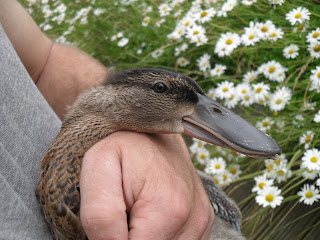This is our 126th Shoveler (122 ducklings, 4 adults) to be ringed in the valley, but thanks to the WWT this is the first to be colour-ringed, which we hope will be re-sighted and add to our existing knowledge of Shoveler duckling movements. A number of recoveries from metal ringed birds have already come our way - out of a brood of two ducklings ringed in 2004, both birds made their way to Russia where they were recovered in 2005, and in 1997/98 two ducklings from the valley were recovered in France - see previous post for more details - Shoveler(ly) good.
Pages
- Home
- Feb' 24
- Jan' 24
- Dec' 23
- Nov' 23
- Oct' 23
- Sep' 23
- Aug' 23
- July 23
- June 23
- May 23
- Apr' 23
- Mar' 23
- Feb' 23
- Jan' 23
- Dec' 22
- Nov' 22
- Oct' 22
- Sept' 22
- Aug' 22
- Jul' 22
- Jun' 22
- May 22
- Apr' 22
- Mar' 22
- Feb' 22
- Jan' 22
- Dec' 21
- Nov' 21
- Oct' 21
- Sep' 21
- Aug' 21
- Jun' 21
- Jul' 21
- Mar' 21
- May 21
- Apr' 21
- Feb' 21
- Nov' 20
- Jan' 21
- Dec' 20
Welcome to the LDV NNR ringing blog, this blog is designed to share the experiences, findings and tales from a group of dedicated ringers. We specialise in conservation orientated research projects, largely focusing on wildfowl, waders, owls and birds of conservation concern, in and around the Vale of York NNR's.
NB - Whilst the purpose of this blog was initially designed to cover our nationally important wildfowl ringing activities, it now also features wildlife and work posts, explaining how we manage the NNR for both wildlife and people.
For daily sightings please visit our Twitter account: https://twitter.com/ldv_nnr (@LDV_NNR)
For details of events, volunteer tasks and wildlife images please visit our Facebook account: https://www.facebook.com/Lower-Derwent-Valley-Skipwith-Common-NNR
Monday 16 July 2012
10/07/12 - Spoonbill?! ;)
This is our 126th Shoveler (122 ducklings, 4 adults) to be ringed in the valley, but thanks to the WWT this is the first to be colour-ringed, which we hope will be re-sighted and add to our existing knowledge of Shoveler duckling movements. A number of recoveries from metal ringed birds have already come our way - out of a brood of two ducklings ringed in 2004, both birds made their way to Russia where they were recovered in 2005, and in 1997/98 two ducklings from the valley were recovered in France - see previous post for more details - Shoveler(ly) good.




No comments:
Post a Comment